
Nahe (wine region)
Encyclopedia

German wine
German wine is primarily produced in the west of Germany, along the river Rhine and its tributaries, with the oldest plantations going back to the Roman era. Approximately 60 percent of the German wine production is situated in the federal state of Rhineland-Palatinate, where 6 of the 13 regions ...
, along the River Nahe in the state
States of Germany
Germany is made up of sixteen which are partly sovereign constituent states of the Federal Republic of Germany. Land literally translates as "country", and constitutionally speaking, they are constituent countries...
of Rhineland-Palatinate
Rhineland-Palatinate
Rhineland-Palatinate is one of the 16 states of the Federal Republic of Germany. It has an area of and about four million inhabitants. The capital is Mainz. English speakers also commonly refer to the state by its German name, Rheinland-Pfalz ....
. On the region's 4155 hectares (10,267.2 acre) of vineyards in 2008, white wine grapes dominate with 75% and Riesling
Riesling
Riesling is a white grape variety which originated in the Rhine region of Germany. Riesling is an aromatic grape variety displaying flowery, almost perfumed, aromas as well as high acidity. It is used to make dry, semi-sweet, sweet and sparkling white wines. Riesling wines are usually varietally...
is the most common variety with 27.2%. A characteristic of the Nahe region is that the soils are very varied owing to the region's volcanic origins.
Although the region was populated already in Roman
Ancient Rome
Ancient Rome was a thriving civilization that grew on the Italian Peninsula as early as the 8th century BC. Located along the Mediterranean Sea and centered on the city of Rome, it expanded to one of the largest empires in the ancient world....
times, and the village of Monzingen
Monzingen
Monzingen is a municipality in the district of Bad Kreuznach in Rhineland-Palatinate, in western Germany.Founded over 1200 years ago the village contains a number of historic buildings .-References:...
was mentioned as a wine
Wine
Wine is an alcoholic beverage, made of fermented fruit juice, usually from grapes. The natural chemical balance of grapes lets them ferment without the addition of sugars, acids, enzymes, or other nutrients. Grape wine is produced by fermenting crushed grapes using various types of yeast. Yeast...
village as early as 778, the Nahe wine region was defined only with the 1971 German wine law. Before that, the wines were sold as plain "Rhine wine". In recent decades, several Nahe producers have made a name for themselves with Riesling wines that have been rated very highly by international wine critics, and have come to be seen as being on par with the best wines of Moselle and Rheingau
Rheingau (wine region)
Rheingau is one of 13 German wine regions for quality wines . Named for the traditional region of Rheingau , the wine region is situated in the state of Hesse, where it makes up part of the Rheingau-Taunus-Kreis administrative district...
wines.
History
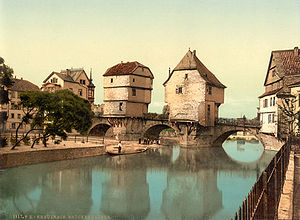
Middle Ages
The Middle Ages is a periodization of European history from the 5th century to the 15th century. The Middle Ages follows the fall of the Western Roman Empire in 476 and precedes the Early Modern Era. It is the middle period of a three-period division of Western history: Classic, Medieval and Modern...
, viticulture
Viticulture
Viticulture is the science, production and study of grapes which deals with the series of events that occur in the vineyard. When the grapes are used for winemaking, it is also known as viniculture...
was flourishing the region under the care of Church-run vineyards
Christian Church
The Christian Church is the assembly or association of followers of Jesus Christ. The Greek term ἐκκλησία that in its appearances in the New Testament is usually translated as "church" basically means "assembly"...
. During the 19th century, the Nahe was considered one of Germany's finest wine regions and continued its prosperity till experiencing economic downturns following the world war
World war
A world war is a war affecting the majority of the world's most powerful and populous nations. World wars span multiple countries on multiple continents, with battles fought in multiple theaters....
s of the 20th century. While other German wine regions became more industrialized, the more rural Nahe fell behind and its presence on the world's wine market was dramatically reduced. Towards the end of the 20th century, reforms and renewed optimism among the Nahe winemakers would usher in a period of renaissance in the Nahe wine industry.
Climate and geography
The Nahe wine region follows the path of the Nahe river in its northeasterly descent towards the Rhine. The river helps moderate the temperate climate of the region and the valleys of the Nahe's tributariesTributary
A tributary or affluent is a stream or river that flows into a main stem river or a lake. A tributary does not flow directly into a sea or ocean...
help foster diverse microclimates through the region. The Soonwald ranges to the northeast and rocky foothills
Foothills
Foothills are geographically defined as gradual increases in elevation at the base of a mountain range. They are a transition zone between plains and low relief hills to the adjacent topographically high mountains.-Examples:...
to the east help retain heat and moderate the amount of rainfall that the region receives. Some south-facing vineyards have microclimates that are similar to a Mediterranean climate and are being experimented with for red wine grape cultivation. The Nahe flows parallel to the Moselle and lies 40 kilometres (24.9 mi) to the southeast of the Mosel wine region. The Mittelrhein
Mittelrhein (wine region)
Mittelrhein is a region for quality wine in Germany, and is located along a 120 km stretch of river Rhine in the touristic portions of the Rhine region known as Middle Rhine. On the left bank of Rhine, vineyards begin immediately downstream of the Nahe River estuary and last until Koblenz...
and Rheingau wine regions lie to the north/northeast with the Rheinhessen
Rheinhessen (wine region)
Rheinhessen is the largest of 13 German wine regions for quality wines with under cultivation in 2008. Named for the traditional region of Rhenish Hesse, it lies on the left bank of the River Rhine between Worms and Bingen in the federal state of Rhineland-Palatinate...
forming the region's eastern border. Vineyards are located on steep slopes along the Nahe and its tributaries typically at elevations of 100–300 meters (330-985 ft).
Subregions
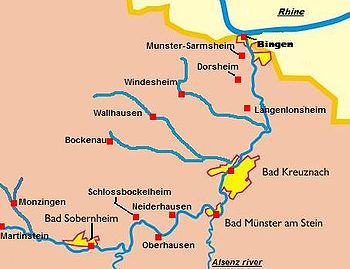
Martinstein
Martinstein is a municipality in the district of Bad Kreuznach in Rhineland-Palatinate, in western Germany. With an area of 0.39 km² it is the smallest Gemeinde in Germany....
, near the historic village of Monzingen and then downstream to its confluence
Confluence
Confluence, in geography, describes the meeting of two or more bodies of water.Confluence may also refer to:* Confluence , a property of term rewriting systems...
with the Rhine at Bingen am Rhein
Bingen am Rhein
Bingen am Rhein is a town in the Mainz-Bingen district in Rhineland-Palatinate, Germany.The settlement’s original name was Bingium, a Celtic word that may have meant “hole in the rock”, a description of the shoal behind the Mäuseturm, known as the Binger Loch. Bingen was the starting point for the...
. The region is broadly divided into three subregions, though there are quality wines that carry the "Nahe" designation that are produced outside of these. The main regions are the Upper Nahe, Bad Kreuznach
Bad Kreuznach
Bad Kreuznach is the capital of the district of Bad Kreuznach, Rhineland-Palatinate, Germany. It is located on the Nahe river, a tributary of the Rhine...
and Lower Nahe. The wine-producing areas outside of these subregions includes the river Alsenz area that meets the Nahe at Bad Münster am Stein-Ebernburg
Bad Münster am Stein-Ebernburg
Bad Münster am Stein-Ebernburg is a municipality in Germany in the state of Rhineland-Palatinate, district of Bad Kreuznach. The town has about 4000 inhabitants as of 2004 and covers an area of 9.53 square km and lies on the Nahe....
and the villages of Bockenau
Bockenau
Bockenau is a municipality in the district of Bad Kreuznach in Rhineland-Palatinate, in western Germany....
, Roxheim
Roxheim
Roxheim is a municipality in the district of Bad Kreuznach in Rhineland-Palatinate, in western Germany....
, Sommerloch
Sommerloch
Sommerloch is a municipality in the district of Bad Kreuznach in Rhineland-Palatinate, in western Germany.administrative region.-Location:Sommerloch lies northwest of Bad Kreuznach in the vicinity of the Nahe Valley, on the edge of the Soonwalds. The village is surrounded by vineyards. Seven...
and Wallhausen
Wallhausen, Rhineland-Palatinate
Wallhausen is a municipality in the district of Bad Kreuznach in Rhineland-Palatinate, in western Germany....
several miles northwest of the Nahe.
The Nahe formally has only one overlapping district Bereich Nahetal that includes 7 Grosslagen (collective sites) and 328 Einzellagen (vineyards). The 7 Grosslagen are:
- Grosslage Burgweg-on the Upper Nahe, shares a name with Grosslagen in the Rheingau and FranconiaFranconia (wine region)Franconia is a region for quality wine in Germany situated in the north west of Bavaria in the district of Franconia, and is the only wine region in the federal state of Bavaria...
. Most noted for its Riesling wine production. - Grosslage Paradiesgarten-on the Upper Nahe, includes the historic village of Monzingen. Some producers here are noted for their Rieslings of cult wine status.
- Grosslage Kronenberg-in the Bad Kreuznach region, considered one of the best quality Grosslagen in the Nahe.
- Grosslage Pfarrgaten-northwest of Bad Kreuznach around the village of Wallhausen, one of the Nahe's smallest Grosslagen.
- Grosslage Rosengarten-northwest of Bad Kreuznach, shares a name with a Grosslage in the Rheingau; the region is widely planted with Müller-ThurgauMüller-ThurgauMüller-Thurgau is a variety of white grape which was created by Hermann Müller from the Swiss Canton of Thurgau in 1882. It is a crossing of Riesling with Madeleine Royale. It is used to make white wine in Germany, Austria, Northern Italy, Hungary, England, in Australia, Czech Republic, Slovakia,...
and SilvanerSilvanerSylvaner or Silvaner is a variety of white wine grape grown primarily in Alsace and Germany, where its official name is Grüner Silvaner. In Germany it is best known as a component of Liebfraumilch and production boomed in the 1970s to the detriment of quality, but it has long enjoyed a better...
. - Grosslage Schlosskapelle-on the Lower Nahe, one of the Nahe's most promising Grosslagen for Pinot blancPinot BlancPinot blanc is a white wine grape. It is a point genetic mutation of Pinot noir. Pinot noir is genetically unstable and will occasionally experience a point mutation in which a vine bears all black fruit except for one cane which produced white fruit....
and Pinot grisPinot grisPinot gris is a white wine grape variety of the species Vitis vinifera. Thought to be a mutant clone of the Pinot noir grape, it normally has a grayish-blue fruit, accounting for its name but the grape can have a brownish pink to black and even white appearance...
. - Grosslage Sonnenborn-on the Lower Nahe and centered around the village of LangenlonsheimLangenlonsheimLangenlonsheim is a municipality in the district of Bad Kreuznach, in Rhineland-Palatinate, Germany. It is situated on the river Nahe, approx. 6 km north-east of Bad Kreuznach and 9 km south of Bingen am Rhein...
.
Upper Nahe
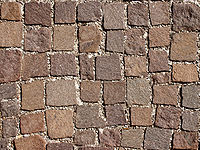
Oberhausen
Oberhausen is a city on the river Emscher in the Ruhr Area, Germany, located between Duisburg and Essen . The city hosts the International Short Film Festival Oberhausen and its Gasometer Oberhausen is an anchor point of the European Route of Industrial Heritage. It is also well known for the...
where a single vineyard can include soils of sandstone
Sandstone
Sandstone is a sedimentary rock composed mainly of sand-sized minerals or rock grains.Most sandstone is composed of quartz and/or feldspar because these are the most common minerals in the Earth's crust. Like sand, sandstone may be any colour, but the most common colours are tan, brown, yellow,...
, slate
Slate
Slate is a fine-grained, foliated, homogeneous metamorphic rock derived from an original shale-type sedimentary rock composed of clay or volcanic ash through low-grade regional metamorphism. The result is a foliated rock in which the foliation may not correspond to the original sedimentary layering...
, melaphyre and porphyry
Porphyry (geology)
Porphyry is a variety of igneous rock consisting of large-grained crystals, such as feldspar or quartz, dispersed in a fine-grained feldspathic matrix or groundmass. The larger crystals are called phenocrysts...
. This region of the Nahe was modernized during the Flurbereinigung
Flurbereinigung
Flurbereinigung is the German word used to describe land reforms in various countries, especially Germany and Austria. The term can best be translated as land consolidation. Another European country where those land reforms have been carried out is France...
reforms of the late 20th century and is now characterized by steep, terrace
Terrace (agriculture)
Terraces are used in farming to cultivate sloped land. Graduated terrace steps are commonly used to farm on hilly or mountainous terrain. Terraced fields decrease erosion and surface runoff, and are effective for growing crops requiring much water, such as rice...
d vineyards along the banks of the Nahe planted mostly with Riesling. The climate of the region gets progressively warmer downstream with low amounts of annual rainfall that is favorable for the production of late harvest wine
Late harvest wine
Late harvest is a term applied to wines made from grapes left on the vine longer than usual. Late harvest is usually an indication of a sweet dessert wine, such as late harvest Riesling. Late harvest grapes are often more similar to raisins, but have been naturally dehydrated while on the vine...
s.
Wine villages of the Upper Nahe include-(moving downstream)
- Monzingen-including the Frühlingsplätzchen and Halenberg vineyards
- MeddersheimMeddersheimMeddersheim is a municipality in the district of Bad Kreuznach in Rhineland-Palatinate, in western Germany. It is superregionally known for its annual "Weinfest", a traditional celebration, and its sausages....
-including the Rheingrafenberg vineyard - Schlossböckelheim-including the Felsenberg and Kupfergrube vineyards
- Oberhausen-including the Brücke vineyard
- NiederhausenNiederhausenNiederhausen is a municipality in the district of Bad Kreuznach in Rhineland-Palatinate, in western Germany. It has a reputation for producing some of the finest riesling wines in the Nahe region....
-including the Hermannshöhle and Kerz vineyard. A 1901 classification of Nahe's vineyard carried out by the office of the Royal PrussianKingdom of PrussiaThe Kingdom of Prussia was a German kingdom from 1701 to 1918. Until the defeat of Germany in World War I, it comprised almost two-thirds of the area of the German Empire...
SurveyorSurveyingSee Also: Public Land Survey SystemSurveying or land surveying is the technique, profession, and science of accurately determining the terrestrial or three-dimensional position of points and the distances and angles between them...
listed the Hermannshöhle vineyard as the highest-ranking vineyard on the Nahe. - NorheimNorheimNorheim is a municipality in the district of Bad Kreuznach in Rhineland-Palatinate, in western Germany....
-including the Dellchen and Kirschheck vineyards - TraisenTraisen, GermanyTraisen is a municipality in the district of Bad Kreuznach in Rhineland-Palatinate, in western Germany....
-including the Bastei and Rotenfels vineyards
Bad Kreuznach
The subregion of Bad Kreuznach includes the vineyards north of the town that are dominated with clayClay
Clay is a general term including many combinations of one or more clay minerals with traces of metal oxides and organic matter. Geologic clay deposits are mostly composed of phyllosilicate minerals containing variable amounts of water trapped in the mineral structure.- Formation :Clay minerals...
- and loess
Loess
Loess is an aeolian sediment formed by the accumulation of wind-blown silt, typically in the 20–50 micrometre size range, twenty percent or less clay and the balance equal parts sand and silt that are loosely cemented by calcium carbonate...
-based soils. The area has been traditionally led by large family-owned estates, such as those of the Anheuser family
Anheuser family
The Anheuser family is a German wine family from the Nahe in the Rhineland-Palatinate. The American brewery family of Anheuser-Busch fame are descendants of Eberhard Anheuser who was born in Bad Kreuznach...
(of which the brewer Eberhard Anheuser
Eberhard Anheuser
Eberhard Anheuser was a German-born soap and candle maker as well as the father-in-law of Adolphus Busch, the founder of the Anheuser-Busch Company. He and two of his brothers moved to America in 1842. He was a major creditor of the Bavarian Brewery Company, a struggling brewery founded in 1853...
was a part) and the Reichsgrafen von Plettenberg
House of Plettenberg
The House of Plettenberg is a Westphalian noble family of the Uradel. It dates back at least to 1187, when Heidolphus de Plettenbrath was mentioned in a document by Philip I...
who are still producing wine today. These families were instrumental in the years after World War II
World War II
World War II, or the Second World War , was a global conflict lasting from 1939 to 1945, involving most of the world's nations—including all of the great powers—eventually forming two opposing military alliances: the Allies and the Axis...
in sustaining the reputation of Nahe wine but the Bad Kreuznach region, as a whole, has seen a steady decline since the end of the 20th century with very few vineyards participating in the VDP (Verband Deutscher Prädikats- und Qualitätsweingüter
Verband Deutscher Prädikats- und Qualitätsweingüter
Verband Deutscher Prädikats- und Qualitätsweingüter e.V. or the Association of German Prädikat Wine Estates, is an organisation where most of Germany's top wine producers are members. It is commonly known under its acronym VDP...
) organization. The region still has some quality vineyards with the Kahlenberg and Krötenpfuhl being the most significant.
Lower Nahe
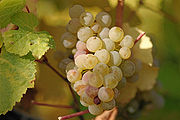
Quartzite
Quartzite is a hard metamorphic rock which was originally sandstone. Sandstone is converted into quartzite through heating and pressure usually related to tectonic compression within orogenic belts. Pure quartzite is usually white to gray, though quartzites often occur in various shades of pink...
and slate. In addition to Riesling, Scheurebe
Scheurebe
Scheurebe or Sämling 88 is a white wine grape variety. It is primarily grown in Germany and Austria, where it often is called Sämling 88 , and some parts of the New World...
, Silvaner and Pinot blanc all have significant plantings in this area. The wines of the Lower Nahe tend to have more similarities to the wines of the Mittelrhein rather than the wines from other parts of the Nahe. This includes characteristic flavors of wet stones and mineral
Mineral
A mineral is a naturally occurring solid chemical substance formed through biogeochemical processes, having characteristic chemical composition, highly ordered atomic structure, and specific physical properties. By comparison, a rock is an aggregate of minerals and/or mineraloids and does not...
s with citrus
Citrus
Citrus is a common term and genus of flowering plants in the rue family, Rutaceae. Citrus is believed to have originated in the part of Southeast Asia bordered by Northeastern India, Myanmar and the Yunnan province of China...
and stone fruit notes.
Wine villages of the Lower Nahe include-moving north
- DorsheimDorsheimDorsheim is a municipality in the district of Bad Kreuznach in Rhineland-Palatinate, in western Germany. The village of Dorsheim is situated on one of the higher western flanks of the Trollbach valley, just 4 km up from Münster Sarmsheim, which is where the valley ends abruptly in the form of...
-including the vineyards of Troll-Bach, Burgberg, Goldloch and Pittermännchen - Münster-SarmsheimMünster-SarmsheimMünster-Sarmsheim is an Ortsgemeinde – a municipality belonging to a Verbandsgemeinde, a kind of collective municipality – in the Mainz-Bingen district in Rhineland-Palatinate, Germany.-Location:...
-including the vineyards of Dautenflänzer and Pittersberg - LaubenheimLaubenheimLaubenheim is a municipality in the district of Bad Kreuznach in Rhineland-Palatinate, in western Germany....
-including the vineyard of St. Remigiusberg - WindesheimWindesheim, GermanyWindesheim is a municipality in the district of Bad Kreuznach in Rhineland-Palatinate, in western Germany.-External links:*...
-including the vineyard of Rosenberg
Grapes and wine
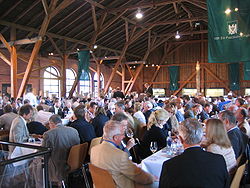
Müller-Thurgau
Müller-Thurgau is a variety of white grape which was created by Hermann Müller from the Swiss Canton of Thurgau in 1882. It is a crossing of Riesling with Madeleine Royale. It is used to make white wine in Germany, Austria, Northern Italy, Hungary, England, in Australia, Czech Republic, Slovakia,...
which was once the Nahe's most widely planted variety but now accounts for around 16% of plantings. In the 1960s, Silvaner occupied more than half of all vineyards on the Nahe but fell in favor to plantings of Müller-Thurgau and Riesling such that it now accounts for a little less than 10%. Plantings of Pinot blanc, Pinot gris and the red Pinot noir
Pinot Noir
Pinot noir is a black wine grape variety of the species Vitis vinifera. The name may also refer to wines created predominantly from Pinot noir grapes...
have been increasing. Overall, red grape varieties account for around 23% of the Nahe's vineyards with Dornfelder
Dornfelder
Dornfelder is a dark-skinned variety of grape of German origin used for red wine. It was created by August Herold at the grape breeding institute in Weinsberg in the Württemberg region in 1955. Herold crossed the grape varieties Helfensteiner and Heroldrebe, the latter which bears his name, to...
, Blauer Portugieser
Blauer Portugieser
Blauer Portugieser is a red Austrian and German wine grape found primarily in the Rheinhessen, Pfalz and wine regions of Lower Austria. It is also one of the permitted grapes in the Hungarian wine Egri Bikavér . In Germany, the cultivated area covered or 4.5% of the total vineyard area in 2007...
and Pinot noir being the most popular plantings. Other varieties found in the Nahe include Bacchus, Faberrebe
Faberrebe
Faberrebe or Faber is a grape variety used for white wine. It was created in 1929 by Georg Scheu at the Landesanstalt für Rebenzüchtung in Alzey and was released with varietal protection in 1967. Scheu created Faberrebe by crossing Pinot Blanc and Müller-Thurgau...
and Kerner
Kerner (grape)
The Kerner grape is an aromatic white grape variety. It was bred in 1929 by August Herold by crossing Trollinger and Riesling. Herold was working at a plant breeding station in Lauffen in the Württemberg region of Germany. This station belonged to a state breeding institute headquartered in...
.
For a large part of the Nahe's history, grapes from the region were blended with other German wine grapes and labeled as "Rhine wine". Today the majority of Nahe wine is consumed domestically with the nine member estates of the VDP having the largest export market of the region. Unlike other German wine regions, co-operatives have a smaller presence that pales in comparison to the influences of the large German supermarket chains that form a large sector of the Nahe wine market.
The most cultivated grape varieties, by area in 2008, were:
|
Scheurebe Scheurebe or Sämling 88 is a white wine grape variety. It is primarily grown in Germany and Austria, where it often is called Sämling 88 , and some parts of the New World... , 131 ha (3.2%) Blauer Portugieser Blauer Portugieser is a red Austrian and German wine grape found primarily in the Rheinhessen, Pfalz and wine regions of Lower Austria. It is also one of the permitted grapes in the Hungarian wine Egri Bikavér . In Germany, the cultivated area covered or 4.5% of the total vineyard area in 2007... , 112 ha (2.7%) Regent (grape) Regent is a dark-skinned inter-specific hybrid grape variety, used for making wine. It has both European and American vine species in its pedigree and a broad resistance against the most significant fungal diseases which affect grapes, such as downy mildew.Regent was created in 1967 by Professor... , 101 ha (2.4%) Chardonnay Chardonnay is a green-skinned grape variety used to make white wine. It is originated from the Burgundy wine region of eastern France but is now grown wherever wine is produced, from England to New Zealand... , 39 ha (0.9%) Faberrebe Faberrebe or Faber is a grape variety used for white wine. It was created in 1929 by Georg Scheu at the Landesanstalt für Rebenzüchtung in Alzey and was released with varietal protection in 1967. Scheu created Faberrebe by crossing Pinot Blanc and Müller-Thurgau... , 30 ha (0.7%) Gewürztraminer Gewürztraminer is an aromatic wine grape variety that performs best in cooler climates. It is sometimes referred to colloquially as Gewürz, and in French it is written '... , 25 ha (0.6%) Dunkelfelder Dunkelfelder is a dark-skinned variety of grape used for red wine. It was created by Germanviticulturalist Gustav Adolf Froelich . He probably crossed Färbertraube with Blauer Portugieser... , 23 ha (0.6%) Huxelrebe Huxelrebe is a white grape used for wine. Huxelrebe is primarily found in Germany, where the cultivated area covered in 2006, with a decreasing trend. It is primarily found in the German wine regions Rheinhessen, Palatinate and Nahe. Small plantations are also found in England.- Properties... , 20 ha (0.5%) |

